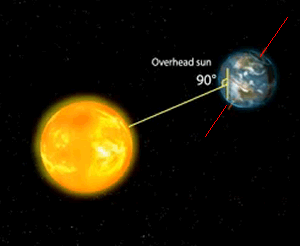source https://www.youtube.com/watch?v=WgHmqv_-UbQ
A 23.5 degree tilt of the Earth on its axis gives us the seasons. Since the Earth's orbit is, somewhat, circular around the Sun seasons are created due to the tilt of the Earth. If there were no tilt, there would be little or no seasonal variation. The only way to create seasons without such an axial tilt is to alter the orbit of the planet, making it extremely eccentric as opposed to the almost circular orbit of the Earth
On the 22 of December the Sun is at a 90 degree angle with the Tropic of Capricorn. The Northern hemisphere is in the Winter solstice while the Southern hemisphere is in the Summer solstice. A solstice occurs twice a year, the Summer solstice and the Winter solstice. The time of the year when the sun reaches its highest point in the summer sky at midday is known as the summer solstice and marks the longest day. On the other side of the world, the winter solstice is marked by the shortest day of the year and occurs when the sun is at its lowest point in the midday sky.
To clarify the difference between a solstice and an equinox think of it this way.
An equinox represents a day where the period of daylight is the same as the period of night, where as a solstice is a day where the period of night or day is at it's longest or shortest. Both a solstice and an equinox occur twice a year.
On the 22 of June the Sun is overhead of the Tropic of Cancer and the Northern hemisphere is in the Summer solstice as it receives the most amount of solar radiation.
On the 22 March the Northern hemisphere is in the Spring equinox
and the Southern hemisphere is in the Autumn equinox. At this time of the year similar solar radiation falls on both hemispheres and the angle of the Sun starts to decrease towards the poles.
On the 22 of September once again similar solar radiation falls on both hemispheres and the Northern hemisphere is in the Autumn equinox while the Southern hemisphere is in Spring equinox.

At what times of the year are the days and nights the same length all over the Earth? Explain why
What is responsible for the seasons?
When the North pole is starting to tilt away from the Sun
When the Antarctic region is experiencing a 24 hour day, Australia is experiencing
What is the main reason why Summer months are warmer than winter months?
What effect does the Earth's tilt have?
During the Spring and Autumn equinoxes the Earth
What is the difference between a solstice and an equinox?
Summer in the Southern hemisphere is the season when the
When the Arctic circle experiences total darkness what is the period of darkness in the Antarctic circle?
How are food chains around the world impacted by Earth's tilt as it orbits the sun?

Life on Earth has evolved to take into account seasonal changes. Suggest how plant-life would have evolved on Earth if there was no axial tilt.
What impact do seasons have on the distribution food crops around the globe?
